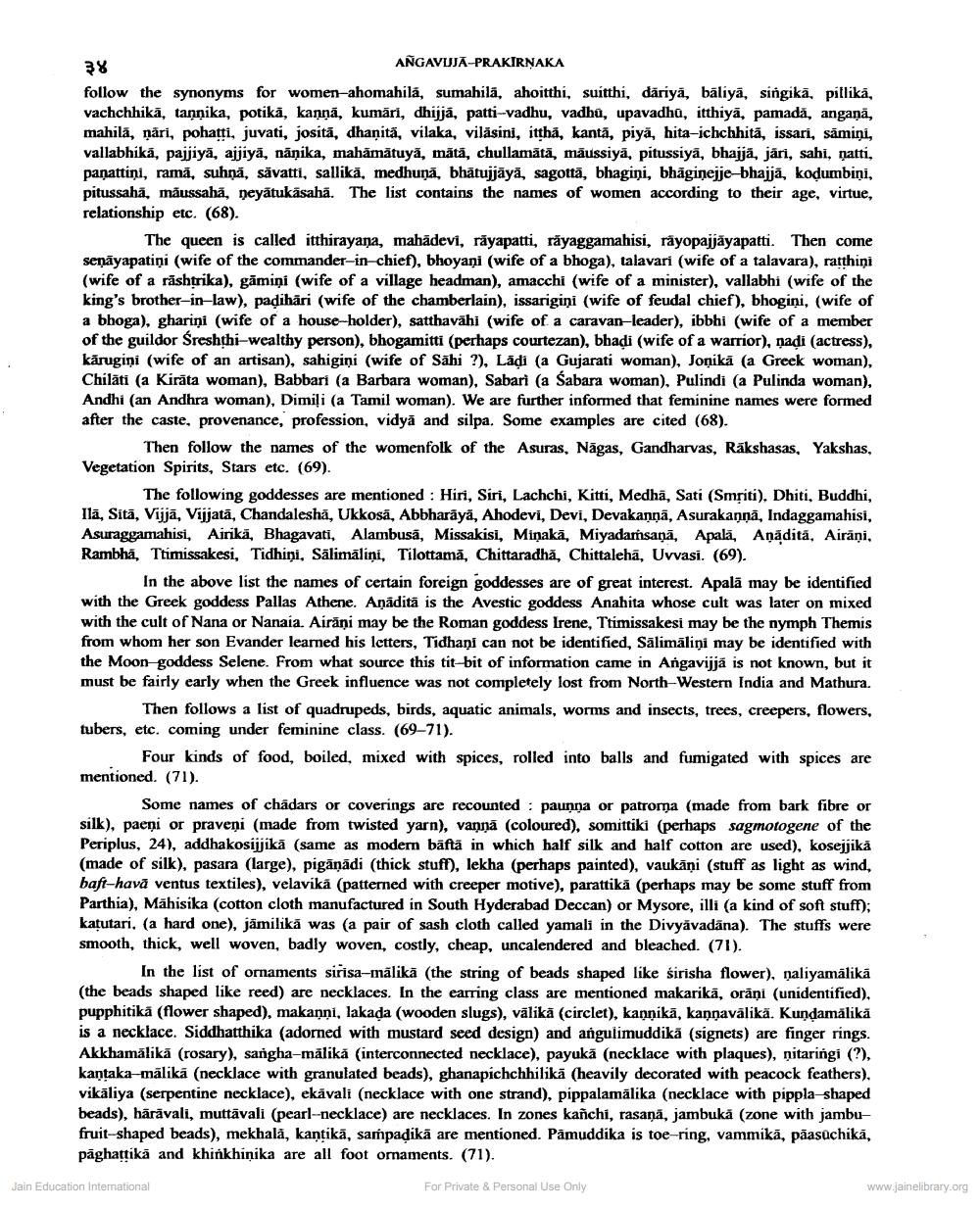________________
38
ANGAVIJĀ-PRAKIRNAKA follow the synonyms for women-ahomahila, sumahilä, ahoitthi, suitthi, dāriya, bāliya, singikā, pillikā, vachchhikā, tannika, potikā, kaņņā, kumāri, dhijjá, patti-vadhu, vadha, upavadha, itthiya, pamada, angaņā, mahilā, ņāri, pohatti, juvati, josită, dhanitā, vilaka, vilasini, itthå, kantā, piya, hita-ichchhită, issari, sāmiņi, vallabhikā, pajjiyā, ajjiyā, nāņika, mahămātuyā, mātā, chullamātā, māussiyā, pitussiyā, bhajjā, jári, sahi, qatti, paņattiņi, ramā, suhņā, sāvatti, sallikā, medhuņā, bhātuijāyā, sagottā, bhagini, bhāginejje-bhajjā, kodumbiņi, pitussahā, maussahā, neyātukasahā. The list contains the names of women according to their age, virtue, relationship etc. (68).
The queen is called itthirayana, mahādevi, rāyapatti, rāyaggamahisi, rayopajjāyapatti. Then come seņāyapatiņi (wife of the commander-in-chief), bhoyani (wife of a bhoga), talavari (wife of a talavara), ratthiņi (wife of a răshtrika), gāmiņi (wife of a village headman), amacchi (wife of a minister), vallabhi (wife of the king's brother-in-law), padihari (wife of the chamberlain), issarigini (wife of feudal chief), bhogini, (wife of a bhoga), ghariņi (wife of a house--holder), satthavähi (wife of a caravan-leader), ibbhi (wife of a member of the guildor Sreshthi-wealthy person), bhogamitti (perhaps courtezan), bhadi (wife of a warrior), nadi (actress), kärugimi (wife of an artisan), sahigini (wife of Sāhi ?), Lādi (a Gujarati woman), Jonikā (a Greek woman), Chilāti (a Kirāta woman), Babbari (a Barbara woman), Sabari (a Śabara woman), Pulindi (a Pulinda woman), Andhi (an Andhra woman), Dimiļi (a Tamil woman). We are further informed that feminine names were formed after the caste, provenance, profession, vidyā and silpa. Some examples are cited (68).
Then follow the names of the womenfolk of the Asuras, Nāgas, Gandharvas, Räkshasas, Yakshas, Vegetation Spirits, Stars etc. (69).
The following goddesses are mentioned: Hiri, Siri, Lachchi, Kitti, Medha, Sati (Smriti), Dhiti, Buddhi, Ilā, Sitā, Vijjā, Vijjatā, Chandaleshā, Ukkosā, Abbharāyā, Ahodevi, Devi, Devakannā, Asurakannā, Indaggamahisi, Asuraggamahisi, Airikä, Bhagavati, Alambusā, Missakisi, Minakā, Miyadarnsaņā, Apala, Anădită, Airāņi, Rambha, Ttimissakesi, Tidhini, Salimāliņi. Tilottamă, Chittaradha, Chittalehā, Uvvasi. (69).
In the above list the names of certain foreign goddesses are of great interest. Apalā may be identified with the Greek goddess Pallas Athene. Anadita is the Avestic goddess Anahita whose cult was later on mixed with the cult of Nana or Nanaia. Airāni may be the Roman goddess Irene, Ttimissakesi may be the nymph Themis from whom her son Evander learned his letters, Tidhani can not be identified, Sālimāliņi may be identified with the Moon goddess Selene. From what source this tit-bit of information came in Angavijja is not known, but it must be fairly early when the Greek influence was not completely lost from North-Western India and Mathura.
Then follows a list of quadrupeds, birds, aquatic animals, worms and insects, trees, creepers, flowers, tubers, etc. coming under feminine class. (69-71).
Four kinds of food, boiled, mixed with spices, rolled into balls and fumigated with spices are mentioned. (71).
Some names of chädars or coverings are recounted : paunna or patrorna (made from bark fibre or silk), paeni or praveņi (made from twisted yarn), vannā (coloured), somittiki (perhaps sagmotogene of the Periplus, 24), addhakosijjikā (same as modern bäftä in which half silk and half cotton are used), kosejjikā (made of silk), pasara (large), pigāņādi (thick stuff), lekha (perhaps painted), vaukāņi (stuff as light as wind, baft-havā ventus textiles), velavika (patterned with creeper motive), parattikä (perhaps may be some stuff from Parthia), Mähisika (cotton cloth manufactured in South Hyderabad Deccan) or Mysore, illi (a kind of soft stuff); katutari. (a hard one), jämilika was a pair of sash cloth called yamali in the Divyavadana). The stuffs were smooth, thick, well woven, badly woven, costly, cheap, uncalendered and bleached. (71).
In the list of ornaments sirisa-malikā (the string of beads shaped like sirisha flower), naliyamālikā (the beads shaped like reed) are necklaces. In the earring class are mentioned makarikā, orāņi (unidentified), pupphitika (flower shaped), makanni, lakada (wooden slugs), vālikā (circlet), kannikā, kannavälikä. Kundamålikā is a necklace. Siddhatthika (adorned with mustard seed design) and angulimuddika (signets) are finger rings. Akkhamālikā (rosary), sangha-mālikā (interconnected necklace), payukā (necklace with plaques), nitaringi (?), kantaka-mālikā (necklace with granulated beads), ghanapichchhilikā (heavily decorated with peacock feathers). vikāliya (serpentine necklace), ekávali (necklace with one strand), pippalamālika (necklace with pippla-shaped beads), hārāvali, muttāvali (pearl-necklace) are necklaces. In zones kañchi, rasaņā, jambuka (zone with jambu, fruit-shaped beads), mekhalā, kantikā, sampadikā are mentioned. Pämuddika is toe-ring, vammikā, pāasuchikā, pāghattika and khinkhiņika are all foot ornaments. (71).
Jain Education International
For Private & Personal Use Only
www.jainelibrary.org




